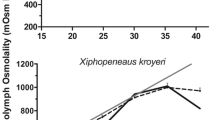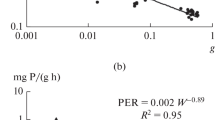Abstract
The metabolic reactions ofArenicola marina andNereis diversicolor (both euryoxic and euryhaline polychaetes from the intertidal) to hyposmotic shock under anaerobic conditions were investigated in 1987–1988 using specimens from the East Frisian Wadden Sea. Although reductions in salinity were within the limits of tolerance under normoxic conditions, during anoxia they resulted in increased stress and a significant reduction in survival time. Both species were unable to sufficiently intensify anaerobic energy production to match the increased requirement for energy during adaptation to hyposmotic conditions. Moreover, as an adaptation to anoxic conditions, worms reduced their metabolic activity after the first 6 h. Thus, specimens remained more swollen than at the same reduction in salinity under normoxic conditions. InA. marina only the extracellular volume was reduced all be it to a limited extent.N. diversicolor probably reacted in the same or similar way. In both species, cells remained swollen. The concentrations of cellular free amino acids were not reduced; that means the main mechanism of cellular volume regulation was not activated under these conditions.
Similar content being viewed by others
Literature cited
Amende, L. M., Pierce, S. K. (1980). Free amino acid mediated volume regulation of isolatedNoetia ponderosa red cells: control by Ca2+ and ATP. J. comp. Physiol. (Sect. B) 138: 291–298
Bergmeyer, H. U. (ed.) (1984). Methods of enzymatic analysis. Vol. VI. Metabolites 1, 3rd edn. Verlag Chemie, Weinheim
Bergmeyer, H. U. (ed.) (1985). Methods of enzymatic analysis. Vol. VII. Metabolites 2, 3rd edn. Verlag Chemie, Weinheim
Boyden, C. R. (1972). The behaviour, survival and respiration of the cocklesCerastoderma edule andC. glaucum in air. J. mar. biol. Ass. U.K. 43: 697–712
Costa, C. J., Pierce, S. K. (1983). Volume regulation in the red coelomocytes ofGlycera dibranchiata: an interaction of amino acid and K+ effluxes. J. comp. Physiol. (Sect. B) 151: 133–144
Dörjes, J., Michaelis, H., Rhode, B. (1986). Long-term studies of macrozoobenthos in intertidal and shallow subtidal habitats near the island of Norderney (East Frisian coast, Germany). Hydrobiologia 142: 217–232
Freeman, R. F. H., Shuttleworth T. J. (1977). Distribution of water inArenicola marina equilibrated to diluted sea water. J. mar. biol. Ass. U.K. 57: 501–509
Gerlach, E. (1986). Untersuchungen zur Abgabe von Aminosäuren durch den Hautmuskelschlauch vonArenicola marina nach hyposmotischem Schock. Diplomarbeit, Universität Münster
Gilles, R. (1987). Volume regulation in cells of euryhaline invertebrates. In: Kleinzeller, A. (ed.) Current topics in membranes and transport, Vol. 30. Cell volume control. Fundamental and comparative aspects in animal cells. Academic Press, San Diego, New York, p. 205–247
Juretschke, H.-P., Kamp, G. (1987). In vivo31P-NMR-spektroskopische Messung des intrazellulären pH-Wertes im WattwurmArenicola marina während Sauerstoffmangel. Verh. dt. zool. Ges. 80: 214
Kluytmans, J. H. F., Veenhof, P. R., Zwaan, A. de (1975). Anaerobic production of volatile fatty acids in the sea musselMytilus edulis L. J. comp. Physiol. (Sect. B) 104: 71–78
Moran, W. M., Pierce, S. K. (1984). The mechanism of crustacean salinity tolerance: cell volume regulation by K+ and glycine effluxes. Mar. Biol. 81: 41–46
Pierce, S. K. (1982). Invertebrate cell volume control mechanisms: a coordinated use of intracellular amino acids and inorganic ions as osmotic solute. Biol. bull. mar. biol. Lab., Woods Hole 163: 405–419
Pierce, S. K., Greenberg, M. J. (1972). The nature of cellular volume regulation in marine bivalves. J. exp. Biol. 57: 681–692
Pierce, S. K., Greenberg, M. J. (1973). The initiation and control of free amino acid regulation of cell volume in salinity stressed marine bivalves. J. exp. Biol. 59: 435–446
Pierce, S. K., Greenberg, M. J. (1976). Hypoosmotic cell volume regulation in marine bivalves: the effects of membrane potential change and metabolic inhibition. Physiol. Zool. 49: 417–424
Pörtner, H. O., Surholt, B., Grieshaber, M. (1979). Recovery from anaerobiosis of the lugwormArenicola marina L.: changes of metabolite concentrations in the bodywall musculature. J. comp. Physiol. (Sect. B) 133: 227–231
Reitze, M., Schöttler, U. (1989). The time dependence of adaptation to reduced salinity in the lugwormArenicola marina (L.) (Annelida, Polychaeta), Comp. Biochem. Physiol. 93A: 549–559
Schöttler, U. (1986). Weitere Untersuchungen zum anaeroben Energiestoffwechsel des PolychaetenArenicola marina L. Zool. Beitr. N. F. 30: 141–152
Schöttler, U., Grieshaber, M. (1988). Adaptation of the polychaete wormScoloplos armiger to hypoxic conditions. Mar. Biol. 99: 215–222
Schöttler, U., Schroff, G. (1976). Untersuchungen zum anaeroben Glykogen-Abbau beiTubifex tubifex. J. comp. Physiol. (Sect. B) 108: 243–254
Schöttler, U., Wienhausen, G. (1981). The importance of the phosphoenolpyruvate carboxykinase in the anaerobic metabolism of two marine polychaetes. In vivo investigations onNereis virens andArenicola marina. Comp. Biochem. Physiol. 68B: 41–48
Schöttler, U., Wienhausen, G., Westermann, J. (1984). Anaerobic metabolism in the lugwormArenicola marina L.: the transition from aerobic to anaerobic metabolism. Comp. Biochem. Physiol. 79B: 93–103
Siegmund, B., Grieshaber, M. K. (1983). Determination of mesoalanopine and D-strombine by high pressure liquid chromatography in extracts from marine invertebrates. Hoppe-Seyler's Z. physiol. Chem. 358: 1455–1461
Storey, B. K. (1985). A re-evaluation of the Pasteur effect: new mechanisms in anaerobic metabolism. Molec. Physiol. 8:439–461
Wiedmeier, V. T., Porterfield, S. P., Hendrich, C. E. (1982). Quantitation of dns-amino acids from body-tissues and fluids using high-performance liquid chromatography. J. Chromat. 231: 410
Zebe, E., Schöttler, U. (1986). Vergleichende Untersuchungen zur umweltbedingten Anaerobiose. Zool. Beitr. N. F. 30: 125–140
Zwaan, A. de, Thillart, G. van den (1985). Low and high power output modes of anaerobic metabolism: invertebrates and vertebrates strategies. In Gilles, R. (ed.) Circulation, respiration and metabolism. Springer Verlag, Berlin, Heidelberg, New York, p. 167–192
Author information
Authors and Affiliations
Additional information
Communicated by O. Kinne, Oldendorf/Luhe
Rights and permissions
About this article
Cite this article
Schöttler, U., Daniels, D. & Zapf, K. Influence of anoxia on adaptation of euryhaline polychaetes to hyposmotic conditions. Mar. Biol. 104, 443–451 (1990). https://doi.org/10.1007/BF01314348
Accepted:
Issue Date:
DOI: https://doi.org/10.1007/BF01314348




